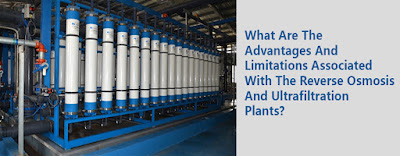What are the advantages and limitations associated with the reverse osmosis and Ultrafiltration plants?
It already is known that there is not just one but there are many and also very huge differences between the reverse osmosis plants and the ultrafiltration plants. The main reason for that is the difference in the technique that is used by both these plants for the treatment of the water it is actually the techniques that make it different for the people.
But we
are not here for the discussion of the difference between the two types of
plants or the water treatment techniques as that has already been discussed in
the previous posts. So, this time here in this guide the discussion will be
focused on the various advantages and the limitations that are associated with
both types of plants.
Though,
it is seen that reverse osmosis in
India is a more popular technique of water treatment as
compared to the UF technique, so yes one can say that reverse osmosis plants
are used more as compared to the Ultrafiltration plant. But still, there are
certain people who are seen confused between the two types of plants as it
comes to making a choice.
·
The plant works on very low powers.
·
The plants are compactly designed and therefore they need less space.
·
There is not much learning or training needed for the operations
of reverse osmosis plants it is so because it works on some standardized
equipment.
·
Mostly the reverse osmosis plants are fully automatic and thus
they do not demand much labor.
·
The RO plants are also very easy to be maintained.
The
limitations associated with the RO water treatment plants are given as follows:
·
As it is a pressure-related technique therefore it becomes
important to have applied pressure exceeded the osmotic pressure.
·
The plant cannot be taken into use without pretreatment as
otherwise, the membrane will start giving a foul smell.
·
The long term investment in the reverse osmosis plant goes higher
in comparison to the UF water treatment plant.
The
advantages associated with the Ultrafiltration plant are given as follows:
·
The UF membranes are available in different sizes therefore the
water treatment through the Ultrafiltration
plant can be done at anywhere on anything.
·
Also, the energy needs of a UF plant are very low.
·
UF is the best water treatment plant for things that are sensitive
to temperature.
·
In the UF plants, it is easy to start the operations again after
switching off the plant.
·
Also, the design of the plants is simple and compact.
The
disadvantages associated with the Ultrafiltration plant are given as follows:
·
The UF plant technique is not capable of removing dissolved salts
from the water.
·
The odor of the water cannot be changed.
·
The water treated by these plants is not suitable for the drinking
purposes of animals or human beings as the dissolved salts in the water are
very harmful to the bodies.
So, this
is all that is there in relation to the advantages and the disadvantages of
reverse osmosis plants and the UF water treatment plants. Through this one can
easily conclude that both types of plants have their own advantages and
disadvantages. So, none of them can be said to be the best all that can be done
is that the person should weigh the advantages and disadvantages of both the
plants as per the requirement and should then decide the one that would suit it
best and should then get that particular plant installed.
One thing that everyone should keep in mind is that the proper treatment of the water has now become a prime necessity as with so much pollution around it is not at all possible to take the water into use without getting it treated properly doing so may lead to unwanted situations such as there might be an increase in the water-borne diseases and that can really be harmful. Also, it is very much necessary to select the right technique and the right plant to be taken into use as per the situation and the requirement of the water as not using the right technique may lead to inefficient workings of the plant.




Comments
Post a Comment